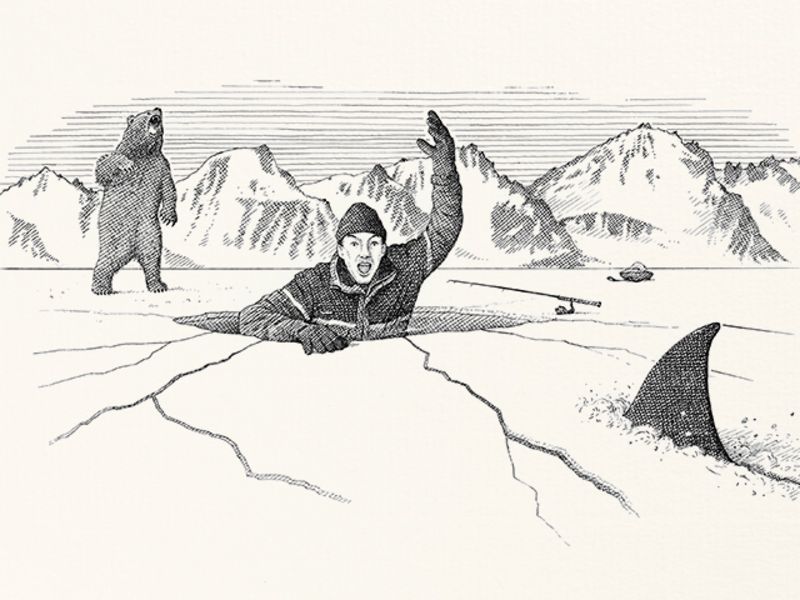THE JOURNAL

I’ve fallen through the ice in a pick-up truck, twice on a snowmobile and three or four times on foot. It’s an occupational hazard – I’ve been ice fishing for 17 years. I have also been the NAIFC president for 10 years and am involved with funding for the US ice fishing team. Based in Minnesota, I travel all over North America, traversing many expanses of ice including Lake Winnipeg in Canada.
The most severe occurrence was when I went through in a truck. We’ve all watched the movies where the hero breaks through the ice and saves the day – it doesn’t happen that way. A truck goes down pretty darn quick. We had to escape through the windows into the water and leave all our equipment behind. We were about a mile from land and our clothing froze – it was like walking in a shell. We got warm just before hypothermia kicked in.
There are a few reasons to be out on the ice, whether it be fishing, playing hockey or skating. My main piece of advice is always “there’s no such thing as safe ice”. I come from a professional ice fishing background so the kit I mention is second nature – but whether you’re a pro-fisherman or an unprepared backpacker, these tips and techniques could save your life.
Things you’ll need (in an ideal world):
1. An ice suit – Striker and Clam make excellent clothing for ice and water conditions
2. Ice cleats (spikes for boots)
3. Ice spud/chisel
4. Ice picks (hung over your neck on some rope, or on a Velcro holder on your jacket)
5. Rope
6. An empty gallon milk jug (to hold your rope)
01.
Know your ice

The first ice of the season occurs around the end of October in Canada. The clear and hard stuff makes for ideal conditions. The clearer it is, the less air bubbles and sediment in the ice. If a river or spring feeds the lake, it can often be thinner. When water has gone through it, it’s soft and mushy or “honeycombed”, and you can feel how weak it is. As it softens, it goes from clear to white to slushy, and in the end it’s black. The honeycombed black ice might be a foot thick but it’s not structurally sound.
02.
Test with your tools

As a guide, you need three to four inches of good ice to walk on, five to six for a snowmobile, and a foot to put a vehicle on. If you’re moving on foot, use your ice spud (which is a 4-5ft chisel), shoving it into the ice to see if it goes through. Walk out 20ft more and punch another hole. Repeat this as you move.
03.
Stay calm and spread yourself

If you go through, immediately put your hands out and spread yourself. When I fell recently, I was more than a mile from land and the water was between 10-0°C. Stay calm and try not to hyperventilate – but get out as quickly as possible because hypothermia is coming. If you can, steady yourself with your ice picks and kick with your feet to get your body flat on the water to spread your weight. If you’re in an upright position, the ice will break when you use your hands to get out.
04.
Rope is your life line

If possible, get someone to throw you a rope. Whoever this is needs to stay back so they don’t fall victim to the same soft ice. Failing this, stay flat in the water, and slowly pull yourself out using the picks (or your hands if you don’t have picks) on the surrounding ice. Persist for as long as it takes. Once out, don’t stand up as that will put pressure on a weak area. Roll away to the last place you knew you had good ice, and get yourself into dry clothing and to a heat source as fast as you can.
05.
If you lose the opening…

If you’re in a heavy vehicle when you go through the ice, your position can shift in the water meaning you’re not directly below the opening. I haven’t seen this happen to anyone who has fallen through on foot – but it does occur. When in a car, make sure you never have your seatbelt on and always have your windows down. Try to get out before you go under the ice – you’re unlikely to survive being upside down at the bottom of a lake. If you are under water and can’t find the opening, blow lots of bubbles to find which way is up and follow the light.
COMMON MISTAKES
Failing to prepare
It doesn’t do you any good to leave any of your kit at home. Simple advice, perhaps, but people constantly think it won’t happen to them.
Playing it cool
People think if they’ve tested one area of ice then it’s fine all the way across the lake. You need to continually check.
Going solo
Never walk out alone. I’ve seen people turn up to a lake with 200ft of rope, tie it to their waist, tie the other end to a car bonnet and walk out by themselves. Not clever.
Following others
If people are already out on the lake, it’s dangerous to assume that the ice is good. There are so many variables: you don’t know the direction they came from. You might have to walk through a bunch of springs to get to them. They also might be willing to take more risks.
Taking the wrong way out
Having fallen through, people will instinctively panic and try to push down on the ice to lift themselves out, without lying flat. The ice will keep breaking and you’ll keep on dunking.
Illustrations by Mr Nick Hardcastle